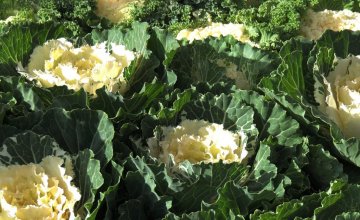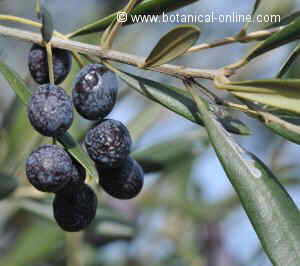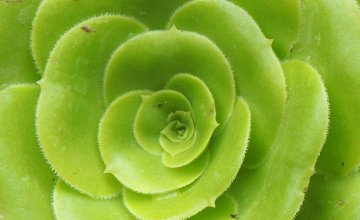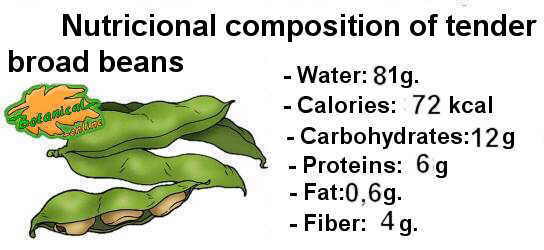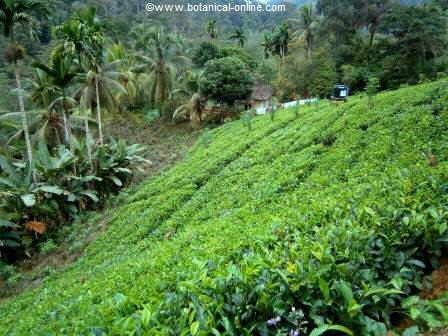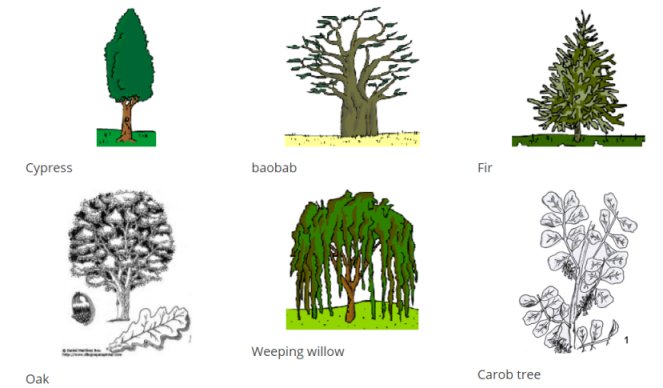Contents
Diffferent classes of trees in the world
Types of trees according to the duration of the leaves
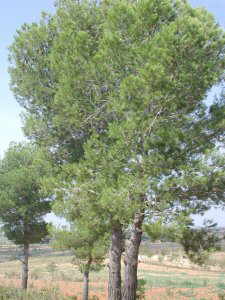
Picture of a pine tree with an evergreen needle-shaped leaf
There are approximately 60.000 o 70.000 species of trees. They can be sorted by numerous criteria, from their use in gardening until the value of its timber.
However, the two main criteria which are usually taken into account are the duration of the leaves and the type of flowers they produce. According to leaf duration trees can be classified into two types:
Evergreen trees
Evergreen trees are those that hold the leaves throughout the year. There is no time when the tree is bare, but the leaves are gradually renewing so while some grow other fall and the cup is always dressed. Within this category have two subcategories:
– — ![]() Tree leaves in the form of scales or needles: Those leaves are narrow, elongated, needle-shaped or scaled, usually rigid and covered with resin.
Tree leaves in the form of scales or needles: Those leaves are narrow, elongated, needle-shaped or scaled, usually rigid and covered with resin.
Within this category we would include those belonging to coniferous trees, such as pines, cypresses, cedars, sequoias or yews.
The spruce, pine and larch are the main species that form large forests in colder areas in the north, from Scandinavia to Siberia and from Alaska to the peninsula of Labrador. This type of forests also occurs in the high mountains of Europe, Asia and America.
—  Evergreen broad-leaved trees: Those that have broader leaves and keep them on the tree throughout the year.
Evergreen broad-leaved trees: Those that have broader leaves and keep them on the tree throughout the year.
Most species of trees from the equatorial areas or tropics fall in this category. Many of them can be found cultivated in warm areas, such as ficus or magnolia. I
t is in this area where you can find more variety of tree species. They are gigantic trees that reach different heights to form different levels of vegetation.
With their wide canopy, evergreen broad-leaved trees will steal the light to the plants of the lower strata, so that only a few plants can live in the ground.
These are plants that can grow and climb vertically in search of light, such as lianas or those hanging from branches or trunks, such as epiphytes.
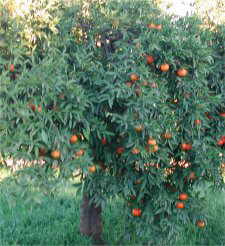
Picture of orange, a tree with an evergreen broadleaf
In temperate zones of the world the number of broad-leaved evergreen trees is smaller, but we also have many representatives as the oak, the olive tree, the sweet bay tree , the orange tree, the willow tree, the eucalyptus and carob.
Some of them form forests, such as oaks and riverside forests where willows are abundant. However, in most cases, these are species that coexist with other tree species or cultivated species.
In cold areas the representatives of evergreen broad-leaved are few though we have some such as the birch, that constitutes huge forest in the taiga.
Deciduous trees
As we move away from the equator trees begin to notice changes in temperature and light along the different seasons.
Deciduous trees are those that remain without leaves during certain periods of the year, which are usually those with less light and less heat. Within the tropics some species are deciduous.
The dominion of deciduous trees is located in the forests of the temperate zones of Europe, North America and Asia. With an area of approximately 18 million square kilometers, these forest areas contain a great variety and richness of trees, most of which drop their leaves when autumn comes.
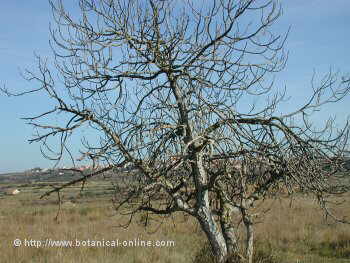
Picture of fig tree, a deciduous tree in winter
The number of species in these areas is much higher than the species in cold areas but much less than the number of species in evergreen forests in the tropics or subtropical areas.
In much drier areas, trees are decreasing in number in favor of quantity and variety of shrubs. Still, in very dry and arid areas of Africa, South America, India and Australia a few trees have adapted to the lack of water, either by reducing their leaves to spines, or losing the leaves in dry seasons.
Among the typical representatives of Africa is baobab (Adansonia digitata)
Baobab tree can be seen in sub-Saharan African savannas and in India. For about 9 months it remains leafless, showing thick and twisted branches where another series of shorter and thinner branches grow.
This peculiar branching, coupled with its thick trunk, gives it the appearance of a tree planted upside down, with the crown embedded in the soil and the roots at the top.
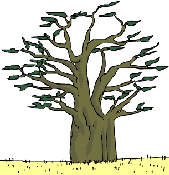
Baobab drawing
![]() More information on perennial and deciduous leaves.
More information on perennial and deciduous leaves.
Types of trees according to flowers
According to the type of flowers, trees ca be classified into two types:
Flowerless trees (gymnosperms)
They are those that produce seeds but these are not enclosed within the carpel, but they are fixed in a number or two at the base of the scales. The scales are distributed on an axis forming a cone or strobil, which is commonly known as cone. Such trees do not produce flowers. Trees belonging to this group are:
– Coniferophyta – Pinophyta: They are known as conifers. They are the most abundant trees within gymnosperms, both in terms of number of species and in number of samples. There are about 630 species of conifers belonging to this division. Most of them are trees. Among all we have firs (Abies / Tsuga), larches (Larix), araucarias (Araucaria), cedars (Cedrus / Calocedrus / Chamaecyparis / Cryptomeria) cypresses (Cupressus / Taxodium), junipers (Juniperus), spruces (Picea), pines (Pinus / Pseudotsuga), Sequoias (Sequoia), yews (Taxus), thujas (Thuja).
 |  |
| Spruce and cypress are two typical gymnosperms (conifers) . | |
– Cycadophyta : – Cycadophyta: There are approximately 350 species of plants in this division which, by the shape of their trunks and leaves, remind palm trees but they have nothing to do with them. It is believed that they already existed about 300 million years ago, but only some remains have been found dating 230 million years ago. They are very old trees that were very abundant in the Jurassic. Today you can find them in the wild in Southeast Asia, Southeast Africa, and Southeast Australia, Central America, Florida and the Caribbean countries. Among the trees included we can mention three families of cycads (Cycadeceae), such as Cycas revoluta, the zamias (Zamiaceae), a family containing the Encephalartos, such as Encephalartos horridus. The third family is the Stangeriaceae, within which there are two genders Stangeria and Bowenia
– Ginkgophyta: – Gingkgophyta: The ginkgo is the sole representative of this division of gymnosperms. It is a dioecious tree, meaning that there are male trees and female trees in this species. It is a very ancient species, as we have traces of gingkoes from the end of the Paleozoic, more than 280 million years ago. The ginkgo tree is the oldest living tree.
– Gnetophyta: – Gnetophyta: Within this division we have only trees in the genus Gnetum.T hese are tropical evergreen trees. The third family of this division is the Welwitschiaceae which has a single representative, Welwitschia mirabilis, although this plant is not a tree but a creeping plant that produces leaves similar to flat ribbons. It lives in the Namib desert.
Trees with flowers (angiosperms)
These are trees whose seeds are enclosed in maturity within the fruit. They have very showy flowers. There are approximately 224,000 known species. These may include:
– Monocotyledons (Liliopsida): With a single cotyledon in the embryo of the seed. There are about 100 species, mainly palms and dragon trees.
– Dicots (Magnoliopsida): With two cotyledons. There are about 60.000 or 70.000 dicots
Types of trees according to branching
Depending on how a branch growth occurs we speak about different types of branching. We distinguish two types of trees:
Monopodial trees
The growth of such trees is caused by elongation of the main stem from the primary bud (1). From the main stem side branches will develop, shorter and thinner, almost in right angles. Because this type of growth, these trees are characterized by more or less triangular shapes. This type of structure, characteristic of the conifers, is an adaptation to the climate where they live. This peculiar shape can rid them of from the excess of snow, which ultimately will break the branches.
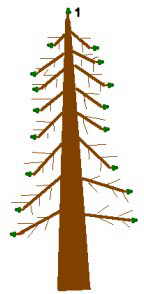
Monopodial tree drawing
Simpodial trees
Most trees are simpodial. It is called so when there is not a main stem that extends through the end of the tree, but two or more main branches arising from the end of the trunk from axillary buds (2) and not from the terminal bud (1). From lateral branches some other ones are born, starting from the end by means of lateral buds. In this kind of growth the branches are formed from different buds. Thus, such a tree type becomes more globose more similar to the shape of an umbrella. This type of structure allows a greater number of leaves can capture sunlight better.
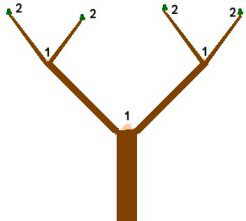
Simpodial tree drawing
![]() More information about trees
More information about trees

